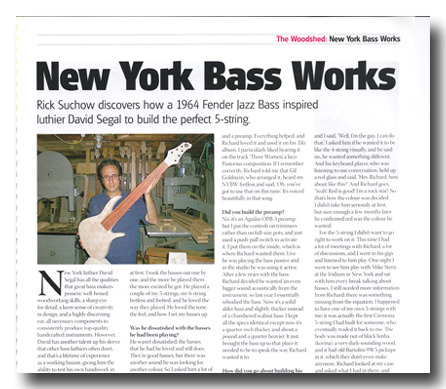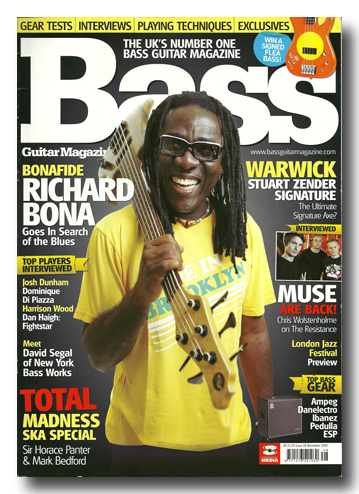(The following article is my interview with luthier David Segal of New York Bass Works, which originally appeared in the November 2009 issue of Bass Guitar Magazine. This is the original, unedited version.)
New York luthier David Segal has all the qualities that great bass makers makers possess: well-honed woodworking skills, a sharp eye for detail, a keen sense of creativity in design, and a highly discerning ear, all necessary components to consistently produce top quality hand crafted instruments. However he also has one additional talent in his arsenal that other bass luthiers often don't, and that's a lifetime of experience as an exceptionally talented and well seasoned bassist, giving him the ability to test his own handiwork in real life situations. Add it all together and you get the impressive line of premium, high performance basses produced by Segal's New York Bass Works.
From his small shop in Massapequa, New York, which David runs with the help of his wife Carla, a talented vocalist in her own right, New York Bass Works, or NBWY as the company's logo reads on every headstock, has become a serious player in the game of high end, high performance basses. Segal's work is catching the attention of bassists everywhere, including world class players such as Richard Bona, for whom David has built his first artist signature line. I caught up with David at his NYBW shop to get the lowdown on the Bona model.
How did your association with Richard Bona begin?
A mutual friend who had worked with Richard at another bass company was here one day and said, "you know, Richard Bona really needs to see your basses", and he called him for me. A week or two later I brought about five basses to Richard, who didn’t seem to be that interested at first. I took the basses out one by one, and the more he played them the more excited he got. He played a couple of my 5-strings, my 6-string fretless and fretted, and loved the way they played, He loved the tone, the feel, how I set my basses up.
Was he dissatisfied with the basses he had been playing or was he just looking for something new?
He wasn’t dissatisfied, the basses that he had he loved and still loves. They’re good basses, they’re still valid, but there was another sound he was looking for, another color. So I asked him a lot of questions, and kept trying to draw out of him what it was he needed that he didn’t have, but he was rather vague. I went to work only half knowing what he wanted, so before building anything I listened to all of his CDs over and over, just grabbing any information I could get sonically. One thing he was specific about was that he wanted a very lightweight bass, a featherweight bass. Now I’m not totally against lightweight or featherweight basses, but at a point you start to lose a lot of the low-mids you need, so against my better judgment I built him a semi-hollow fretless. He loved it immediately.
Semi-hollow meaning you chambered the body.
Chambered, exactly, there are three separate chambers in the bass. What ended up happening was that the bass was a little too light-- under 8 pounds-- and I was going through hoops trying to get it to have a big sound. I tried several things along the way like different pickups and a heavier bridge. I put a preamp inside with tweakers so that bass, mid and treble were all adjustable from the inside. Everything helped, and Richard loved it and used it on his Tiki album. I particularly like hearing it on ‘Three Women’, a Jaco Pastorius composition. If I remember correctly, Richard told me that Gil Goldstein, who arranged it, heard my NYBW fretless and said "oh you’ve got to use that on this tune". It’s voiced beautifully in that song.
Did you build the preamp?
No, it’s an Aguilar OPB-3 preamp, but I put the controls on trimmers rather than on full size pots, and just a push-pull activated it to a setting. I put them on the inside, which is where Richard wanted them. Live he was playing the bass passive and in the studio he was using it active. After a few years with the bass Richard decided he wanted an even bigger sound acoustically from the instrument, so last year I essentially rebodied the bass. Now it‘s a solid alder bass and slightly thicker instead of a chambered, walnut bass. I kept all the specs identical except now it’s a quarter inch thicker, and about a pound and a quarter heavier. It just brought the bass up to that place it needed to be to speak the way Richard wanted it to speak.
How did you go about building his 5-string signature?
That’s the most recent bass I built for him, and its based on my Cremona model. It came out of Richard telling me that he was looking for a particular sound that nobody will build in a 5-string. He said, "Man I just want the 5-string to sound like my old Jazz Bass," and I said, "Well I’m the guy, I can do that. I’m known for doing that." I asked him if he wanted it to be like the 4-string I built for him, and he said no, he wanted something different. And his keyboard player, who was listening to our conversation, held up a red glass and said "hey Richard, how about like this?" And Richard goes "Yeah! Red is good! I’m a rock star!" So that’s how the color was decided. I didn’t take him seriously at first, but sure enough a few months later he confirmed red was the color he wanted. He’s very into the visual.
For the 5-string I didn’t want to go right to work on it because I didn‘t want to go through what I did on the 4-string. This time I had a lot of meetings with Richard, a lot of discussions, and I went to his gigs and listened to him play. One night I went to see him playing with Mike Stern at the Iridium in New York, and sat with him every break talking about basses-- even as Mike kept coming over and cracking jokes! I still needed more information from Richard, there was something missing from the equation and I couldn’t put my finger on it. I happened to have one of my own 5-strings with me, it was actually the first Cremona 5-string I built for someone, who eventually traded it back to me. The body was made out of black limba, a very dark sounding wood, and it had old Bartolini pickups in it which they don’t even make anymore. Richard looked at my case and asked what I had in there, and I said "oh you’re not gonna like it," because to me it didn’t sound like an old Jazz Bass. But he insisted on checking it out, so he played it and said, "This is the sound, this is it. This is the most comfortable 5-string I have ever played in my life, this is perfect." I asked him how my bass with Bartolinis could sound like his old Jazz Bass, and he said that his old jazz bass had Bartolinis in it! So I suggested to Richard that perhaps that bass should be the signature bass, and of course he said, "no, I don’t like the color."
Now I was ready to build him the bass. I knew it had to be on the dark side, so I built it out of red alder. For the neck, I knew I had to back off the titanium reinforced neck I used on his 4-string fretless, so I used graphite, which is the normal construction I always do. I took Bartolini 9W5’s and cast them in soapbars, because Richard likes the soapbars, and eventually added a ramp and midi. The midi option, which is available on any bass I build, is a Roland GK kit, a built-in onboard midi driver. Richard has to have that on his 5-string, he will not work without it. So I did that whole thing, and said ok, this bass is going to be perfect. Sure enough, Richard loved it and toured with it, but decided it didn’t have enough gain. I suggested moving the pickups a little closer to the strings, but he disagreed because he said he needed that distance, and didn’t want to just use more preamp. He wanted more out of the pickup. So in order to get that sound that he liked, but with more gain and keeping the distance and ramp where it was, I made a hybrid pickup, which was a higher-gain version of what he had. And it worked out perfectly, in fact he loved the sound even more.
How did you develop your woodworking skills?
I believe it was when I went to a YMCA camp at 8 years old. It was a great camp, they had arts and crafts, woodworking, metalworking, and I just took to the woodworking. It was amazing that they actually let an 8-year old kid use a band saw and carving tools back then. I got my first lesson in woodworking safety when I saw another kid take a gauge, which is a carving tool, and go right into his arm with it. Blood everywhere.
When did you eventually move on to making instruments?
I was 16 when I bought my first Fender Precision, and I said wow, look at this, I think I could make one of these. Actually, I didn’t attempt to make a bass right away, I made a guitar in shop, my own version of a Stratocaster. I think I made the body out of pine, because I didn’t know what the bodies were made of. I knew the neck was maple, but had no idea what the body was. I made a pine-body Stratocaster!
Tell me about the '64 Jazz Bass you bought in 1980 that you say ‘raised the bar‘ for you.
I had been through at least 20 or 30 Jazz Basses at that point, just bought them and sold them. And I loved Jazz Basses, that’s all I played and all I wanted to play. I was gigging full time, and I noticed that the really old dot inlay pre-CBS basses had that sound I wanted, that warmth and punch, so I actively went out looking for one. I put my name and number in every music store from West Palm to Miami, saying "looking for old Fender Jazz Bass", and within a week I got a call from a guy who said he had a ‘64 Jazz but it was in pretty bad shape. I went over there with 300 bucks in my pocket, that’s all I had. And sure enough it was in bad shape, there was spray all over it, the pickguard was painted black, everything was rusty. I asked him how much he wanted, and he said, "well I’m thinking 300 bucks." I emptied my wallet.
How is it that the old Fenders varied so much? What were the factors that made them so different?
Everything. Wood density, pickups, the way the pickups were wound, even the wire and the gauge of wire that they used and how much winding they did. It varied so much throughout the years, and I found that ‘64 turned out to be, for me, the year that they just seemed to be doing everything right. Up until I got that ‘64 I was building Jazz Bass style instruments for myself, but after I got that bass I said "I don’t need to do this anymore." The bass was as good as it gets, why even go any further? It inspired me to play, it made me practice every day, and I looked forward to the gig every night.
That’s a perfect bass.
It was a perfect bass. Then in 1984 and I was working down in Florida with Randy Bernsen, a great guitar player who had worked with the Zawinul Syndicate for a while, and recorded a couple albums of his own. On a night off, Randy took me to hear a piano player named Ray Lyons, and Ray was using a bass player who played a 6-string Alembic with a low B string on it. I’d been hearing the buzz about bassists playing with a low B, and in fact a producer I worked with had just worked with Anthony Jackson in New York and came down raving about Anthony and his low B string. So we’re listening to this bassist with Ray Lyons and he’s playing that low B string, and everything below E is just killing us. And Randy looks over at me and says ‘It should be a law that every bass player has that!’
So immediately I thought, ok, I guess I'm back into building basses again because I wanted that low B but didn’t want to give up my Jazz Bass for it. I started designing basically a 5-string Jazz Bass. The problem was that I didn’t have a shop, didn’t have the tools, and didn’t have the time, so I commissioned a guy in North Miami to build it for me. I was in the process of moving up to New York, and I got the bass up here and it was totally unusable, just garbage. It was so wrong and there was nothing I could do with it, so I sent it back to him. I went to everyone around New York still looking for the perfect 5-string and couldn’t find what I wanted, so I knew I had to build again. I eventually got some help from a friend who was building guitars and had some woodworking machines in a shop I could work in. I started building for myself, and the next thing I know everybody’s telling me I should build for other people.
Did it take a few prototypes before you were happy with what you came up with?
The first one sounded great, but it didn’t sound like a Jazz Bass at all. It was a great groove bass with a nice big fat solid sound and a really great low B. It was neck thru, and it had that neck thru sound, but I was always looking back at my ‘64 Jazz Bass and thinking ‘I need that’. So I built another one and on a whim, while the neck thru stock was on the table saw, just cut it right off behind the 24th fret area to force myself to build it into a bolt-on design. And that was it! The bass was amazing. I was so proud of it because I knew that I had built what I wanted, and every bass player who played it wanted one.
Why do you prefer bolt-ons?
Tone. It seems there are some guys that build really great neck thrus, and the ones I built were fine as well, but in my opinion and in my experience the bolt-on has more dynamic range, you can dig into it more. It seems to acoustically emulate acoustic instruments more. I won't say that neck thrus are inferior, they're beautiful instruments and fun to build, but the tone of the bolt-on bass, for me, always worked. Wood for wood, material for material, design for design, my preference is the bolt-on. Always has been.
Your thoughts on scale length.
For a 4-string bass any scale from 32 to 34 inches is fine. With the low B string, my belief used to be 36 inch scale, then I backed down to 35 and a half. As string quality and construction got better, and as the string manufacturers started to understand what they were doing with the B string more and more, I was able to pull the scale back even more without any real compromise. If I had to say there was a standard low B scale for me now, it would be 35 inches.
How many basses are you building per year?
It’s up and down, I’d say probably 25, all high performance, hand built customized instruments.
If someone orders a Richard Bona signature model, are you customizing it or do you have standard specs?
I have specs for the Richard Bona model, so when somebody says I want a Richard Bona 4 or 5-string, the only thing we really have to think about is color, or perhaps the midi option. The Richard Bona model means that if I handed this bass to Richard right now he’d be able to take it and go on the road with it and that would be his bass. If it’s not that, then it isn’t the Richard Bona model.
Rick Suchow: Bass
building the richard bona signature bass...
Rick Suchow - Bass Guitar Magazine (Nov, 2009)


